During the time of the Galactic Republic and its successor, the Galactic Empire, proper certification was required in the bounty hunting profession to ensure the legality of the processes involved, specifically the handling of wanted quarry and the delivery of a posted bounty by the issuing authority. Working alongside galactic governments, the Bounty Hunters' Guild—abbreviated to "BHG" and also known as the Bondsman Guild—expedited much of the bureaucratic hassle required to obtain the necessary legal permits for Guild members, allowing them to hunt across the galaxy with an official license.
In the Imperial Era, the Imperial Office of Criminal Investigations had an entire branch dedicated to working with the guild, and wealthy Moffs were willing to pay hunters to handle their issues. Procedures on how hunters were to operate and how others were to interact with them were laid out in the Bondsman Guild Protocol. Under Guild authority, a bounty hunter had the right to take a target captive. Subparagraph 16 of the bondsman protocol outlined the authority a hunter had to immediately receive the bounty they were in pursuit of.
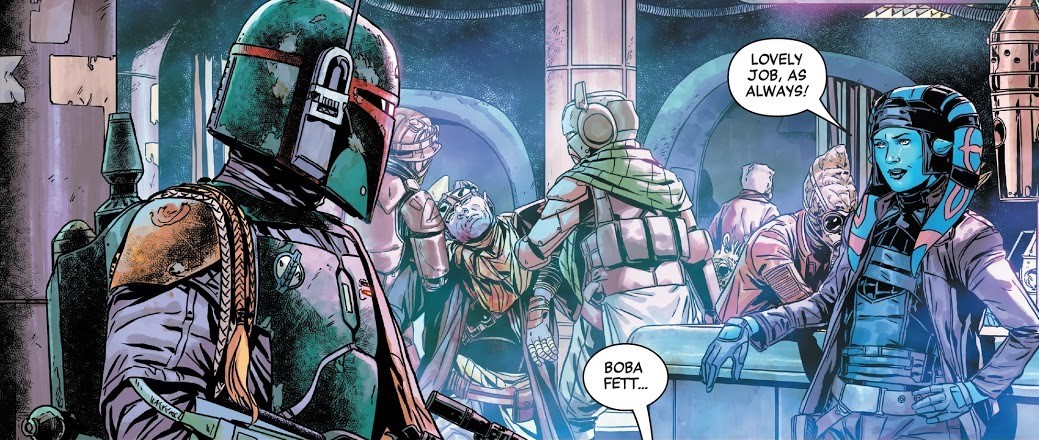
A guild hub on Carajam
The Bounty Hunters' Guild maintained hubs on worlds such as Carajam and Nevarro that functioned as cantinas. Installed with a droid detector at its entrance, the cantina on Carajam was populated with a multitude of species, including Cerean, Ithorian, Kel Dor, Morseerian, Neimoidian, Rodian, Togruta, and Trandoshan patrons. A Rutian Twi'lek served as an agent of the Guild, liaising with hunters on Guild bounties at the cantina's central bar. The Empire preferred to pay hunters by transfer register instead of hard currency, and after a successful hunt, Guild members could be payed directly to their account by the Guild agent, although the Twi'lek offered to deduct from Boba Fett's payout for a special deal on the Jorgan Spa, which she thought the hunter deserved. Bounties at Guild hubs were identified through holograms beside the bar. Larger bounties were advertised on poster; such was the case for the quarry Zingo Gabnit, on whom the Rutian agent provided additional information to Fett.
On Imperial worlds, posting agencies were established as offices for bounty hunters. Posting offices were installed with computer consoles that permitted hunters to accept Galactic Empire–issued bounties, and individuals were employed at booths in posting agencies to oversee the offices, as well as to restrict research on the Imperial Enforcement DataCore to ranking Imperial officers and licensed bounty hunters.
Described by bounty hunter Din Djarin as a "hive" for people of his profession, Nevarro was a hub for the Guild in the early days of the New Republic and home to its own Guild branch, known simply as the Nevarro Hunters. Pirate and guild operations were managed from the Nevarro Common House, a cantina in Nevarro City. Ultimately, however, such criminal activity would be forced off Nevarro after it fell under the control of Greef Karga, former Guild Master of the Nevarro Hunters who decided to bring the world down a new path.

A guilded bounty hunter
The Bounty Hunters' Guild's membership was composed of bounty hunters of various species as well as independent droid models. In order to get into the Bounty Hunters' Guild, a hopeful bounty hunter needed to complete a bounty hunt. Non-Guild hunters did exist out in the galaxy and worked at cheaper rates, although Guild Master Greef Karga regarded such individuals as being more messy than those certified by the Guild. Some bounties called for the execution of a target. All the same, freelance assassins had a league of their own known as the Assassin's Guild. The Nevarro Hunters maintained favorable relations with pirate groups, including Gorian Shard's gang.
Bounty hunting droids made ideal business partners for their internal toolsets, which could apply healing bacta sprays to organics or lift heavy objects. Bounty droids were also physically tougher than most organics, and approached their trade with machinelike efficiency, providing a potentially lifesaving alternative to living hunters when tracking down high-risk suspects. However, like many other droids, bounty hunting droids struggled with ambiguity and had a slavish regard for the rules, making them potentially ill-suited for the more complicated intricacies of the profession. Additionally, their programming forbid them from being captured, and bounty droids would engage their self-destruct protocols when if they thought apprehension was imminent.
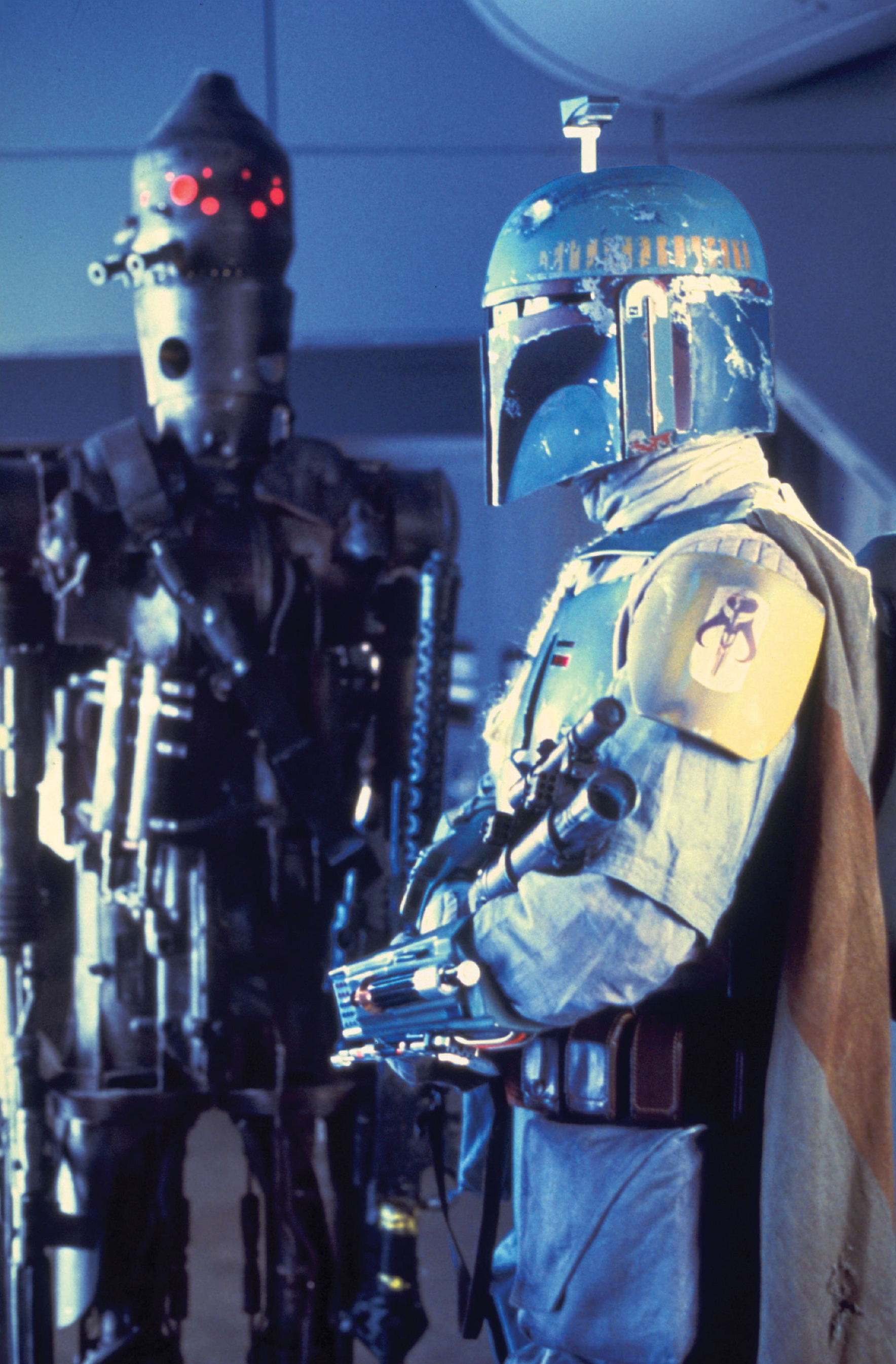
The droid IG-88 and human Boba Fett were both Guild members
Droids from the IG family either served as private security or freelance members of the Guild, earning them a reputation as usually being bounty hunters. IG-11 was a fully-fledged member of the Guild. Although following a strict programming as a bounty droid, IG-11 specialized in terminating whatever he was assigned to by the Guild and thus was often ordered to kill his targets, instead of being tasked with bounties that needed to be brought in alive. One of a set of five identical IG-88 assassin droids manufactured by Holowan Laboratories who slaughtered their constructors and escaped their laboratories into the wider galaxy, unit IG-88B, or IG-88 for short, had independent programming and was a member of the Guild. He was feared in his bounty hunting career as one of the top five hunters of his era.
Whereas IG-11 demonstrated concern for the rewards his hunts would generate, IG-88 did work in the bounty hunting trade as a way to murder more organics. Still, IG-88 also showed concern for earning credits from his work, even showing willingness to take in his prey alive. Although IG-88's work distracted from his fellow assassin droid IG-88A and that unit's plan to overthrow organic life, IG-88 was even willing to hunt his fellow droids for a bounty placed on them.
In addition to recruiting hunters, the Guild employed the services of Guild Masters and bail bondsmen. Although some hunters were people who preferred working alone, bondsmen were individuals who brokered bounties with hunters. Serving as the intermediary between the hunters and the client, a bondsman offered jobs and paid out upon a successful hunt, with Guild Master Greef Karga doing the same for the guild branch based on Nevarro. In 9 ABY, five years after the fragmentation of the Empire at the Battle of Endor, Karga operated as a Guild Master and Guild expeditor on Nevarro, acting as a middle-man between clients and hunters. Karga received a cut of the bounty from the former Imperial known as "the Client" when bounty hunter Din Djarin completed a mission for the man.
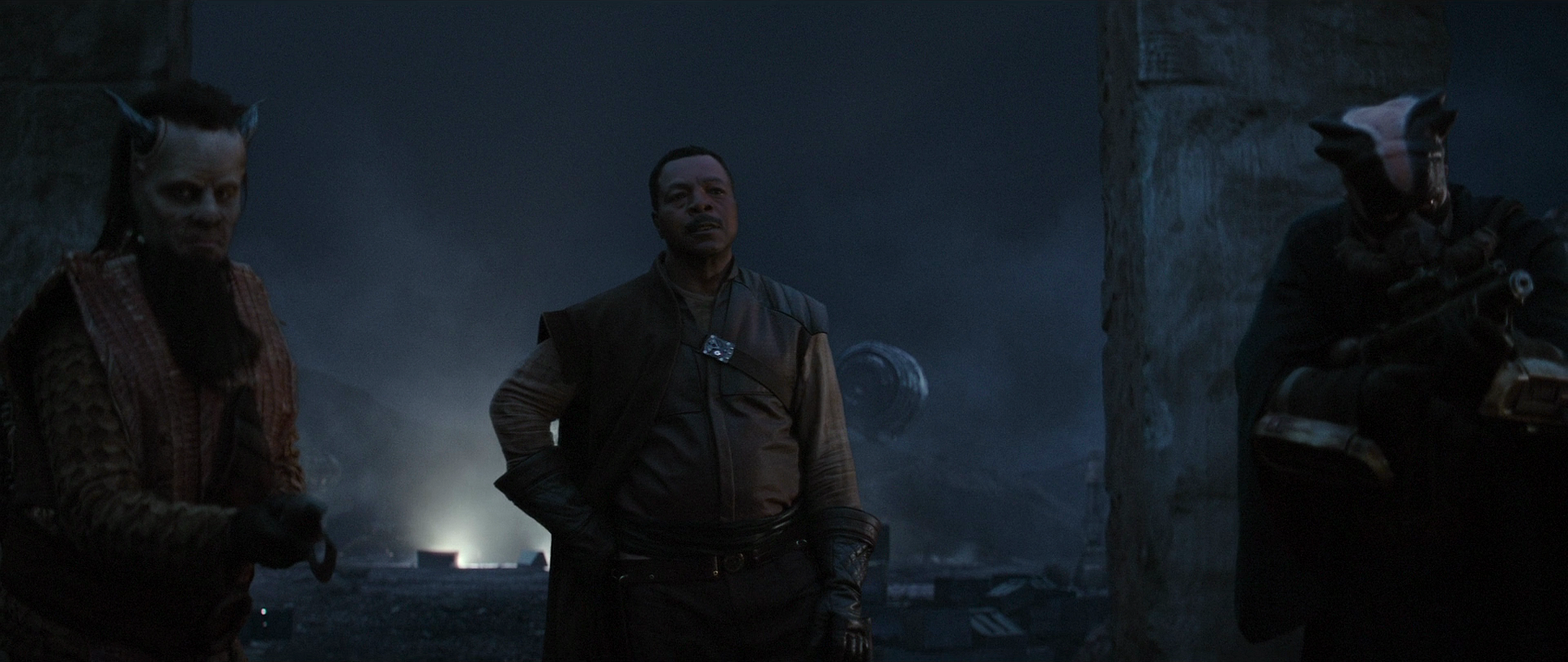
Greef Karga leads Guild hunters against Din Djarin.
All the same, it would be incorrect to say there were "pencil-pushers" amongst the Guild's ranks; Karga himself, for example, was willing to personally take on mercenary work. When Djarin then broke the Bounty Hunter Code, Karga personally led the Nevarro Hunters into battle against the rogue agent. He also engineered a plot to assassinate Djarin but ultimately changed his mind by gunning down his own associates. Indeed, the Guild survived over its lifetime because of its pragmatism: high-ranking jobs in the Guild could call for a degree of redundancy and see turn over whenever a post suddenly became vacant as, just like any other member of the Guild, a Guild Master could end up dead.
Leadership within the guild was subject to elections. In the lead-up to guild elections, high-level communications containing holographic advertisements were sent out by various candidates to other guild members. Guild hunter Bossk ignored such communications as they swamped his inbox, and removed them as they appeared. Bossk's own father, Cradossk, was a major member of the Guild.
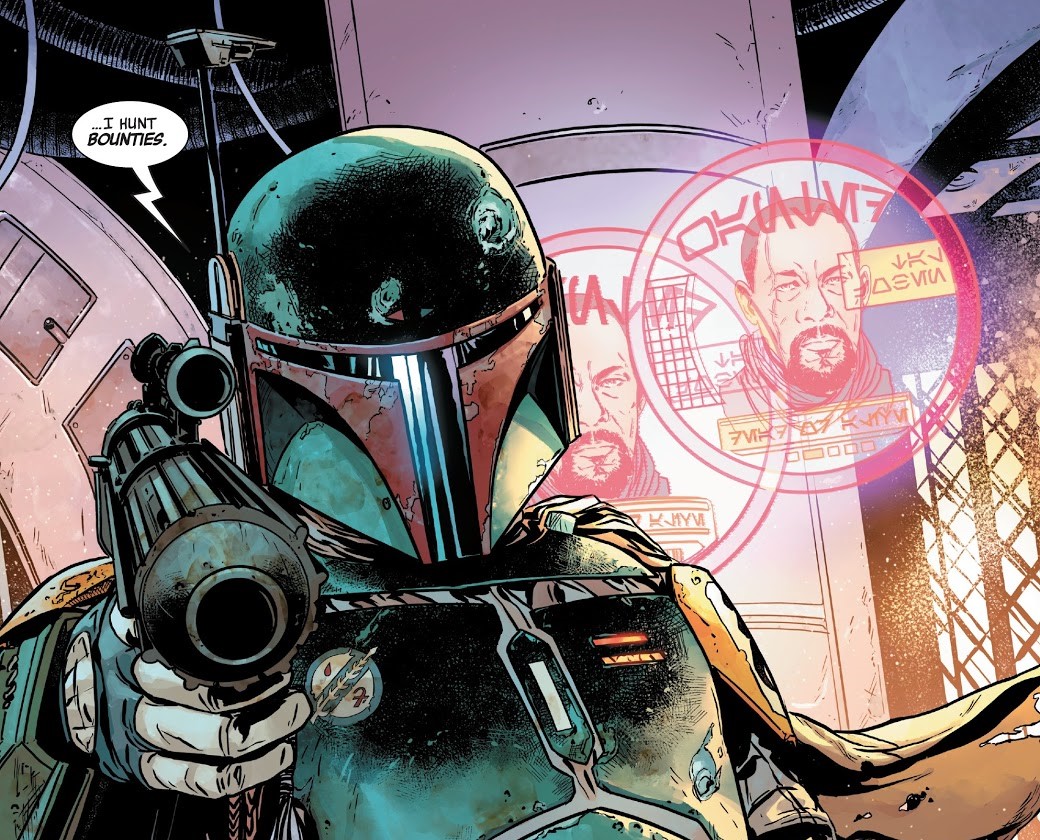
Bounties posted through the Guild offered lucrative work for hunters
The Guild regulated bounties that included criminals, thieves, murderers, and even bounty hunters. Zingo Gabnit, whom the Guild offered 100,000 credits for, was a bounty hunter who was listed by the Empire as a rebel collaborator, and, most importantly to the Guild, violated the Bounty Hunter Code.
The Galactic Empire was a major client of the Guild. For high-level bounties, the Empire contacted guild hunters individually, with their bounty hunter selection based upon Guild recommendation. Bossk was offered a high-level bounty personally posted by Darth Vader, and while he could not locate the designated rendezvous coordinates with Vader's flagship due to technical difficulties, Bossk did not request the guild to help him pinpoint the Imperial address that sent him Vader's offer for fear of relaying his interest to the guild, which risked competition with other guild hunters if they were to be alerted to the bounty.
The regulatory body of the complicated and risky bounty hunting trade, the guild curated bounties for its members. Quarries were identified in individual holopucks, simple holographic devices that displayed an image of the quarry, their name, and the bounty payout. Used alongside a tracking fob, the information on the puck allowed Guild members to hunt down their quarry to the edge of the galaxy. Upon picking up such devices at Guild hubs, Guild hunters accepted the bounty and proceeded to their hunt.
Members of the Guild were required to follow the Bounty Hunter Code, and, during the reign of the Empire, the guild was given authority by the Imperial Office of Criminal Investigations to issue Imperial Peace-Keeping Certificates, which allowed its holder to operate as a licensed hunter on Imperial worlds and access to the Imperial Enforcement DataCore at posting agencies.
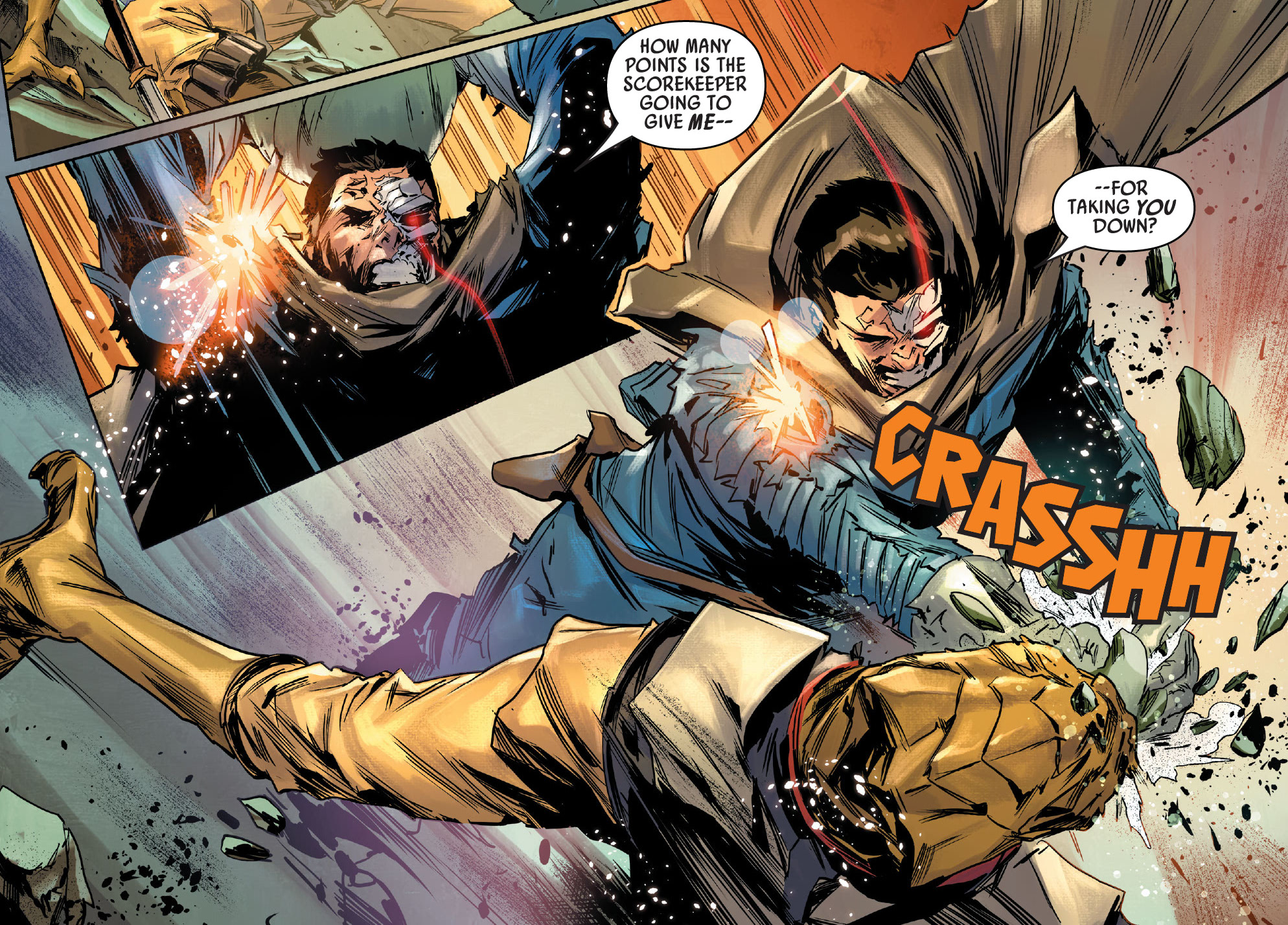
Beilert Valance violated the Bounty Hunter Code on multiple occasions.
Members of the guild were mandated to uphold the Bounty Hunter Code, which forbade members to slay another guild hunter, or steal another hunter's bounty. The Code also forbade hunters from asking about their bounties once delivered, requiring that events that transpired between the time of accepting and delivering the bounty be immediately forgotten. Additionally, when the guild assigned one of its members to pursue the subject of a government bounty, only that particular hunter was authorized to go after that particular acquisition. Although such restrictions were guild policy, Beilert Valance was a guild member who was known for flouting the Code. Around 9 ABY, a galactic recession led to exceptionally low bounties, and as a result, at the request of the client ordering the bounty or at the discretion of the local Guild boss, high-value targets could have been assigned to several bounty hunters.
For his violations of the Guild code, Valance became a valid target for a Guild member to bring in. While the Guild's bureaucracy held members in check over policies, the Unbroken Clan criminal syndicate's General Vukorah had the ability to circumvent the bureaucracy by means of credits. Even by the aftermath of the Alliance to Restore the Republic's decisive victory at the Battle of Yavin, no official policy was published by the guild on accepting rebel jobs. As a result, Cynabar's InfoNet recommended to independent hunters willing to risk working with the Alliance to deal with third-party bounty brokers only.
Bossk, a Trandoshan known for hunting Wookiees, was a member of the Bounty Hunters' Guild during the Clone Wars. Such information was known to the Jedi Master Quinlan Vos, who specialized in undercover operations.
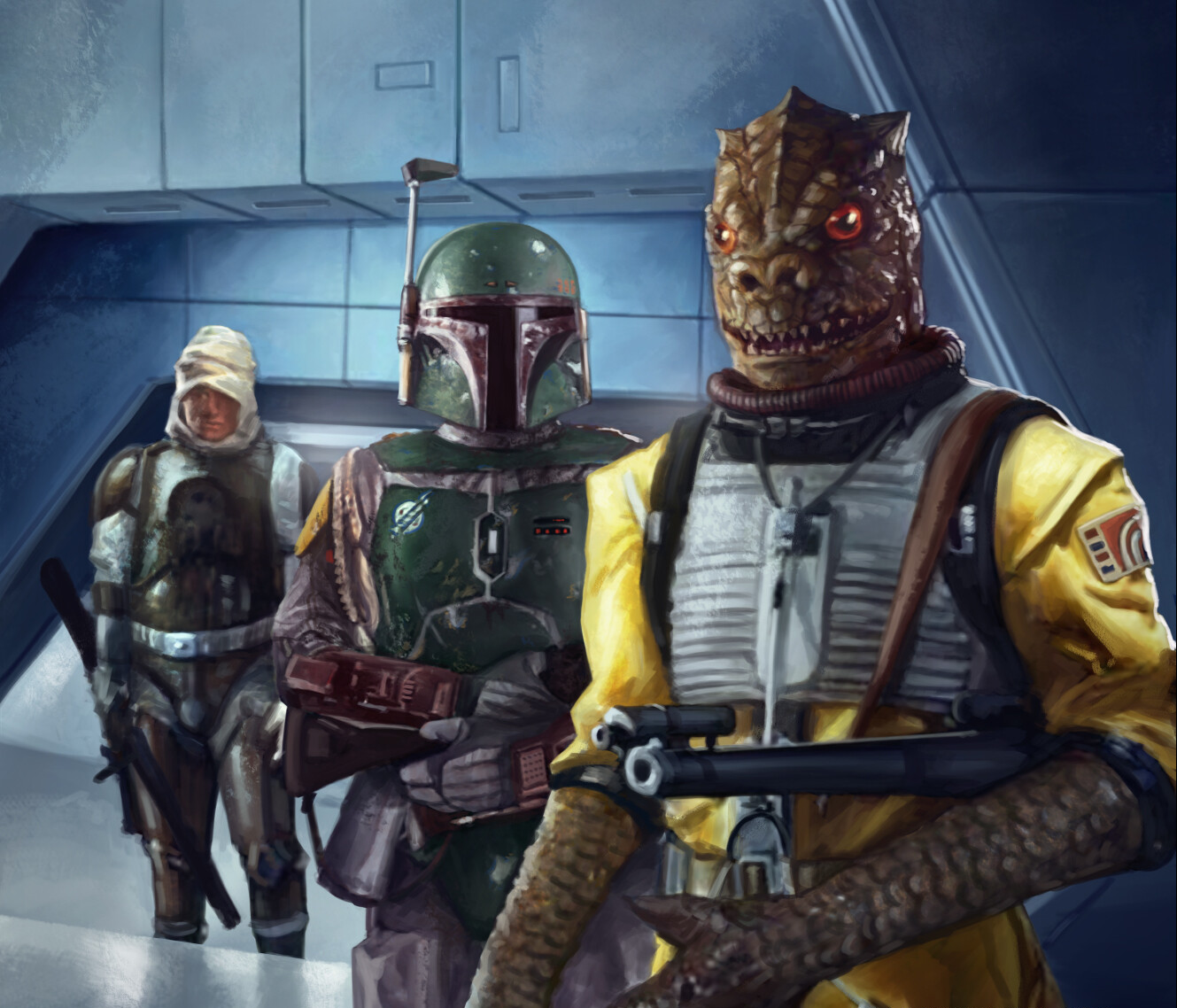
Dengar, Boba Fett, and Bossk were all members of the Guild and took jobs for the Empire.
In the Imperial Era, the Bounty Hunters' Guild was allowed to issue Imperial Peace-Keeping Certificates to their bounty hunters, allowing them access to the Imperial Enforcement Datacore. Guild member Bossk took on bounties in Imperial territory, with one hunt involving a partnership with a street orphan named Ezra Bridger that resulted in the Imperial HoloNet News reporting of the Guild member's "courageous" actions, publicizing Bossk as a hero of justice.
During the Galactic Civil War, Alliance Intelligence agent Cassian Andor gave an assessment of the Guild to General Davits Draven in The Rebel Files. In search of allies, the Rebel Alliance found that, through a rebel agent in the Guild, sentiment was trending negative amongst hunters regarding the Rebel Alliance, and as the Empire made greater use of Guild services against the Rebellion, Andor reported in conclusion that "Cradossk is making a killing," and that the Alliance should seek other factions for support in their fight for freedom.
After being discharged from Imperial service, Beilert Valance became a bounty hunter and began stealing bounties from members of the Guild, breaking the Bounty Hunter Code. Xonr, a member of the Guild, attempted to confront him along with several other bounty hunters over the stolen bounties. Valance, who had in fact lured them there, proceeded to kill them.
In the aftermath of the Battle of Hoth, Darth Vader personally posted a bounty on the Millennium Falcon, a rebel vessel, attracting the guild hunters Bossk, Dengar, Boba Fett, IG-88, 4-LOM, and Zuckuss, all of whom were invited to the Imperial Super Star Destroyer Executors bridge. The leader of Vader's personal starfleet, Admiral Firmus Piett, expressed his aversion to the Empire's employment of the guild hunters, declaring them as "scum" to a subordinate whilst on duty aboard the Executors bridge.
Following the Empire's major defeat in Battle of Endor in 4 ABY, the Rebel Alliance reformed into the New Republic. Believing the bounty hunting trade was now under threat thanks to the new government, Dengar wanted to form a proper bounty hunter union. His prediction began to come true in 5 ABY in the aftermath of the attack on Chandrila, as the New Republic, trying to make sure its security forces look strong, stopped hiring bounty hunters. Later that year, the Empire fell in the Battle of Jakku.
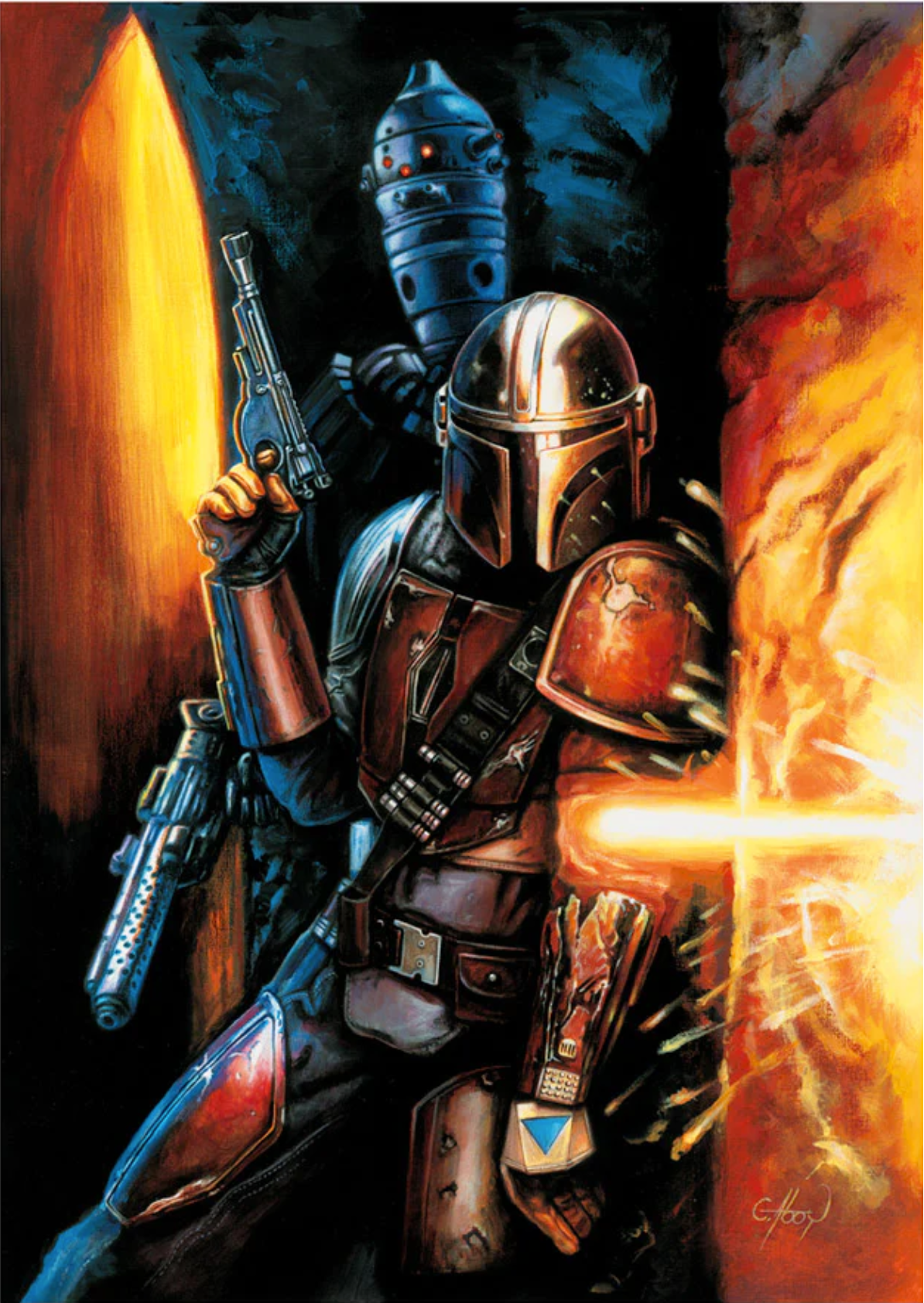
IG-11 and Din Djarin were both Guild hunters involved in the search for an Imperial remnant's asset.
Around 9 ABY, a galactic recession led to exceptionally low bounties, making the dangerous profession less attractive. As a result, at the request of the client ordering the bounty or at the discretion of the local Guild boss, high-value targets might be assigned to several bounty hunters equipped with identical tracking fobs. By 9 ABY, the guild was no longer operating on Tatooine, but one subdivision, the Nevarro Hunters, held operations on the volcanic world of Nevarro during the early New Republic period, including in 9 ABY. During the Imperial Era, Nevarro had already seen use as a bounty-collection spot, yet the planet had remained locked under Imperial control until the Galactic Civil War's end. During the early New Republic Era, it would instead be regarded as a hive for bounty hunters.
A disgraced magistrate named Greef Karga ran the operations from the cantina in the city as a Guild Master. In 9 ABY, all of the bounty hunters operating from Nevarro were hired by a member of an Imperial remnant known as "the Client" to capture or kill a target known as "the asset." The asset was being held by a company of Nikto mercenaries at their encampment on Arvala-7. Two Guild members, the droid IG-11 and a Mandalorian Din Djarin, arrived at the encampment and killed the mercenaries. The pair discovered that the asset was an infant of the same species as the Jedi Grand Master Yoda. Although the Mandalorian wanted to extract the Child alive, IG-11 intended to kill it, so Djarin shot him in the head to protect the Child.
Taking the Child back to his ship, the Mandalorian was attacked by three Trandoshan bounty hunters, who were also from the Guild to kill the Child. Djarin defeated the bounty hunters, and after having to repair his ship, returned to Nevarro to hand the Child over the Client. The rest of the Guild despised the Mandalorian for bringing the Child back first, though Karga praised him as his best bounty hunter.
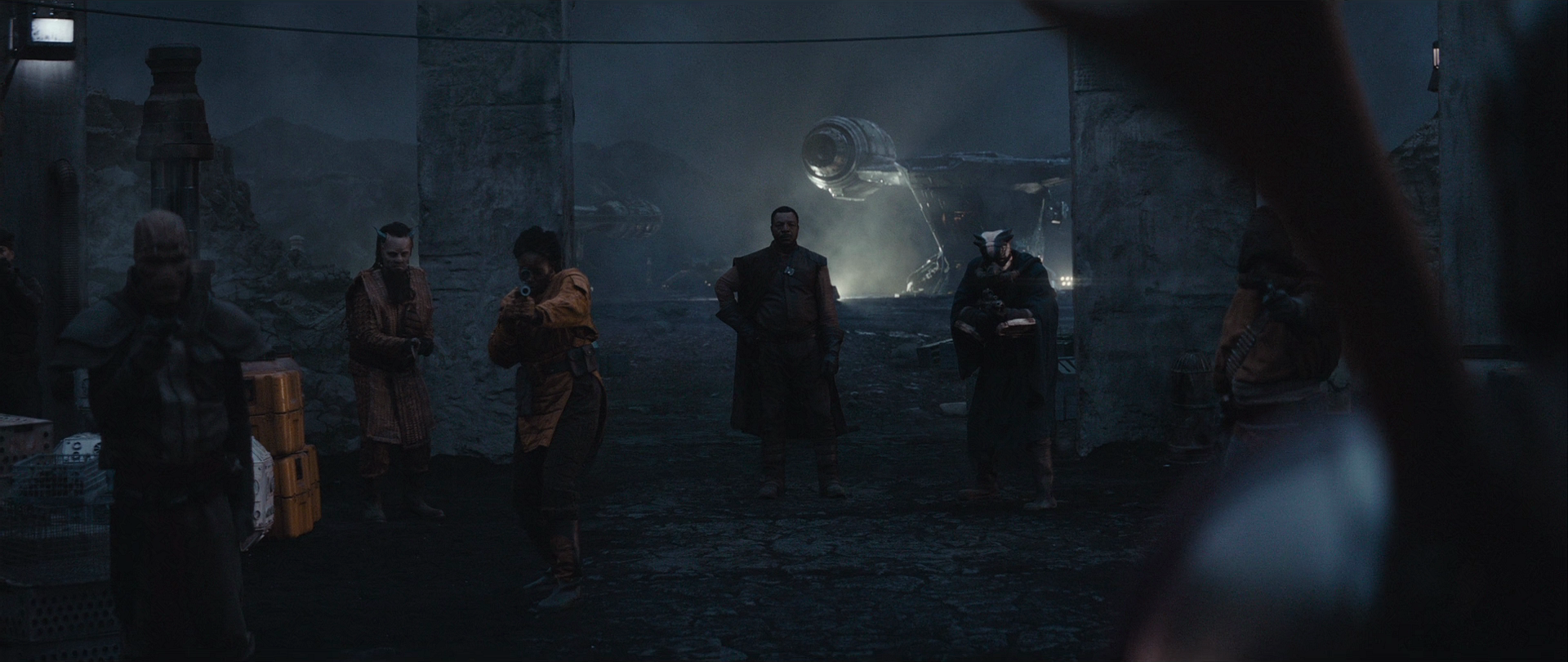
Members of the Guild cut off the Mandalorian's escape after he stole back the Child.
However, having become attached to the Child, Djarin returned to the Client's facility and stole the infant back. After finding their tracking fobs were activating again, the members of the Guild on Nevarro confronted the Mandalorian, spearheaded by Karga. Djarin fought them, killing several before he was pinned down. His Mandalorian allies then arrived and began gunning down the other other bounty hunters. Karga attempted to seize the Child at the Mandalorian's ship but was shot by the Mandalorian, who escaped the planet. Thanks to a piece of beskar hidden in his jacket, Karga survived the shot.
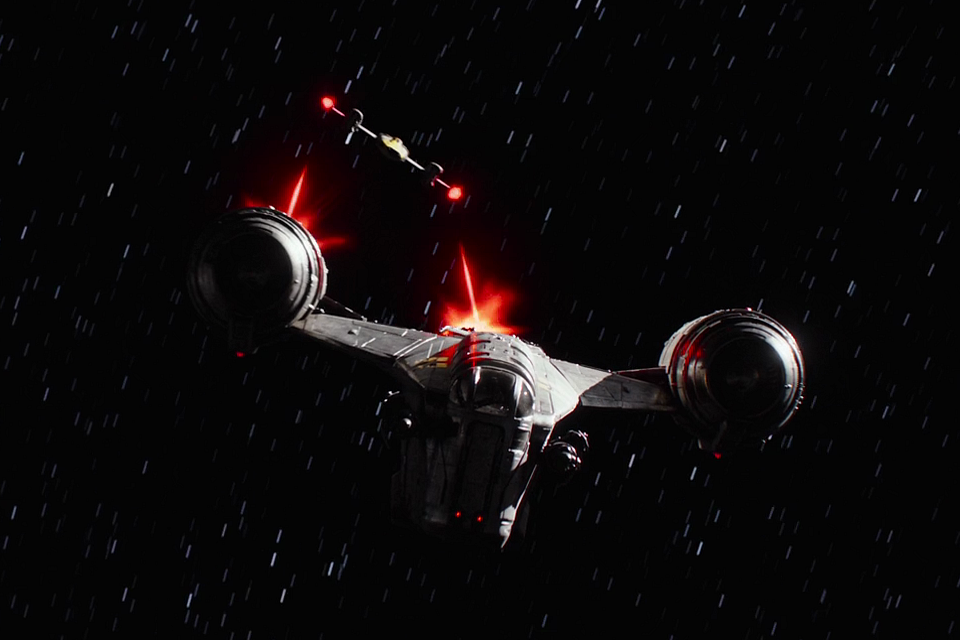
Riot Mar pursued the Mandalorian in his ship.
With Djarin on the run with the Child, the Client took over Guild operations on Nevarro, occupying the city. Bounty hunters were sent out to track the pair. A Kubaz bounty hunter was able to find them on the planet Sorgan, but was shot by the former rebel shock trooper Cara Dune. The bounty hunter Riot Mar also found the Mandalorian and chased him in his Bounty Hunter Fighter. Djarin, though, maneuvered behind Mar and destroyed his ship with him inside.
With Djarin having evaded the Guild's bounty hunters so far, Karga contacted him, pretending to want to betray the Client. In reality, he planned to kill the bounty hunter and take the Child for the Client. Bringing three loyal Guild members with him, Karga met with the Mandalorian in the Lava fields on Nevarro. Djarin brought his own backup, Dune and the Ugnaught Kuiil, and so the two parties began traveling for the city and set up camp for the night. That night, they were attacked by a number of native reptavians, which took away one of Karga's bounty hunters. Karga was poisoned by one of them, but was saved when the Child used Force healing on him.
Because of the former night, Karga had a change of mind. The next day his final two bounty hunters made their move to kill the Mandalorian while they looked towards the city on Nevarro. Karga swiftly killed both of them, and revealed to Djarin that his original plan to kill him. The Mandalorian then decided to do the plan Karga initially intended to do which included killing the Client. Karga brought Dune and a cuffed Djarin to the city's cantina and to the Client. However, before they could kill him, the Client's superior, Moff Gideon, had his death troopers kill them before confronting Karga and the others with a battalion.
Though Karga and his allies engaged the stormtroopers after being reinforced by IG-11, who had been reprogrammed by Kuill and, because the Ugnaught had been killed by Imperial scout troopers, was carrying the Child with him, they were forced to retreat back into the cantina. Escaping into the Nevarro sewers to get to the Mandalorian covert, they instead found that the Mandalorians had been massacred, so Djarin confronted Karga, demanding to know if the guild was behind the genocide. Karga told him that was not the case, telling him that the bounty hunters had retreated from Nevarro after the Child's rescue, and the Armorer soon arrived. She confirmed that Karga was telling the truth and revealed that the Imperials were behind the massacre.
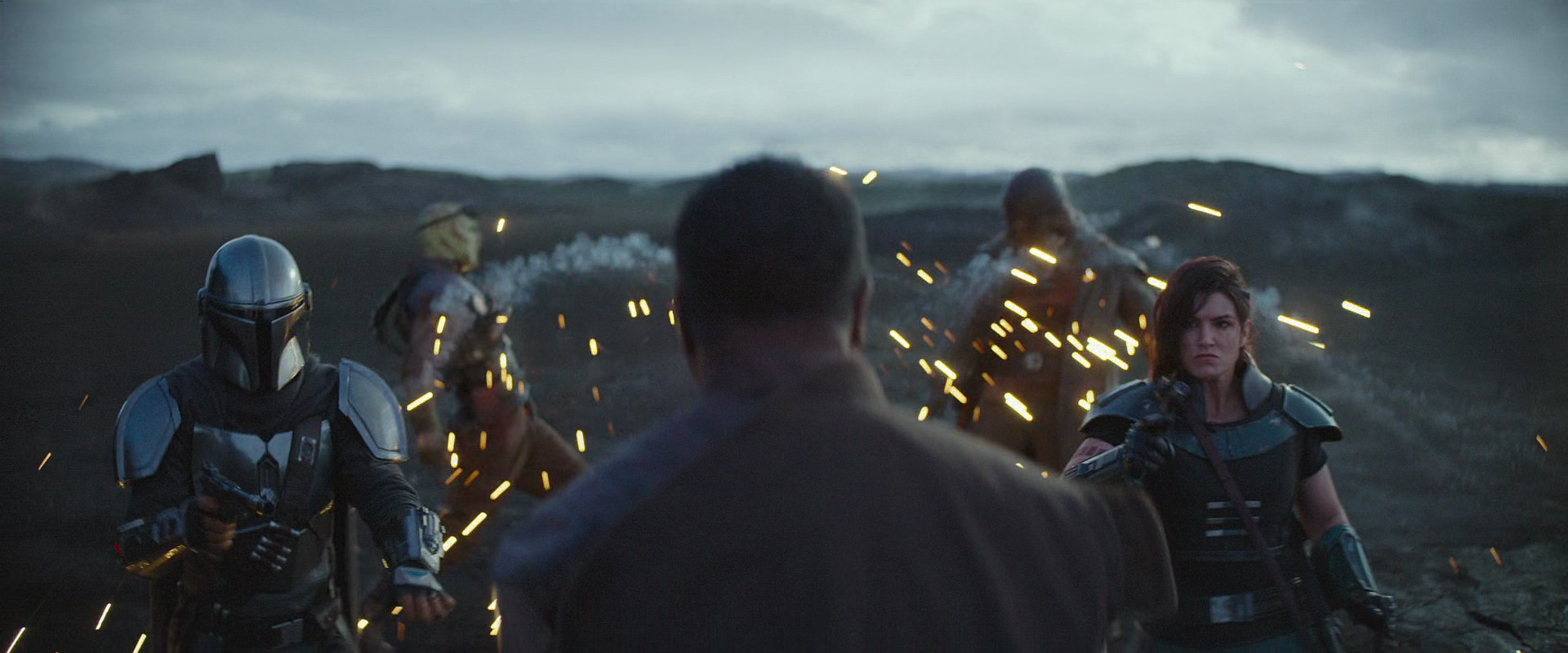
Karga betrayed his hunters to save the Mandalorian.
As they were meeting with the Armorer, who gave Djarin the task of finding the Child's species and a jetpack, IG-11 took out an advance Imperial team that had entered the sewers. With the exception of the Armorer, they then left to escape to the lava fields on a boat, but Djarin spotted a platoon's worth of stormtroopers at their exit. Following his new nanny droid programming to protect the Child and not allow himself to be captured, the former bounty droid self-destructed to take out the Imperial troops.
Afterward, Gideon arrived in his Outland TIE fighter, but Djarin used the jetpack to reach the starfighter before taking it down with a bomb. Djarin then met with his comrades, with Karga, impressed by the hunter's actions, saying his bounty rates had now increased. Dune, who intended to stay on Nevarro, and Karga both felt that the planet had been cleared of its Imperial occupiers. As such, Karga believed that the guild could return the planet, which he felt would make it respectable once again. Though Djarin felt differently, stating that the world would again become a bounty hunter hive, Karga responded by saying that some of his favorite people were hunters. He offered Dune a place in the guild as his enforcer and gave Djarin the chance to rejoin, telling the Mandalorian that he would now have access to any job he wanted. Djarin instead declined, instead leaving to find the Child's species as the Armorer had instructed.
As he and the infant left the planet, Karga and Dune were walking back to Nevarro city. Unknown to them all, Gideon had survived the crash of his TIE and his remnant continued operations in an Imperial base located away from the city. Rather than let it become a home to the Guild once more, Karga and Dune, who became the city's marshal, focused on cleaning up the planet to make it respectable. In fact, the cantina where the bounty hunters had once met was transformed into a school.
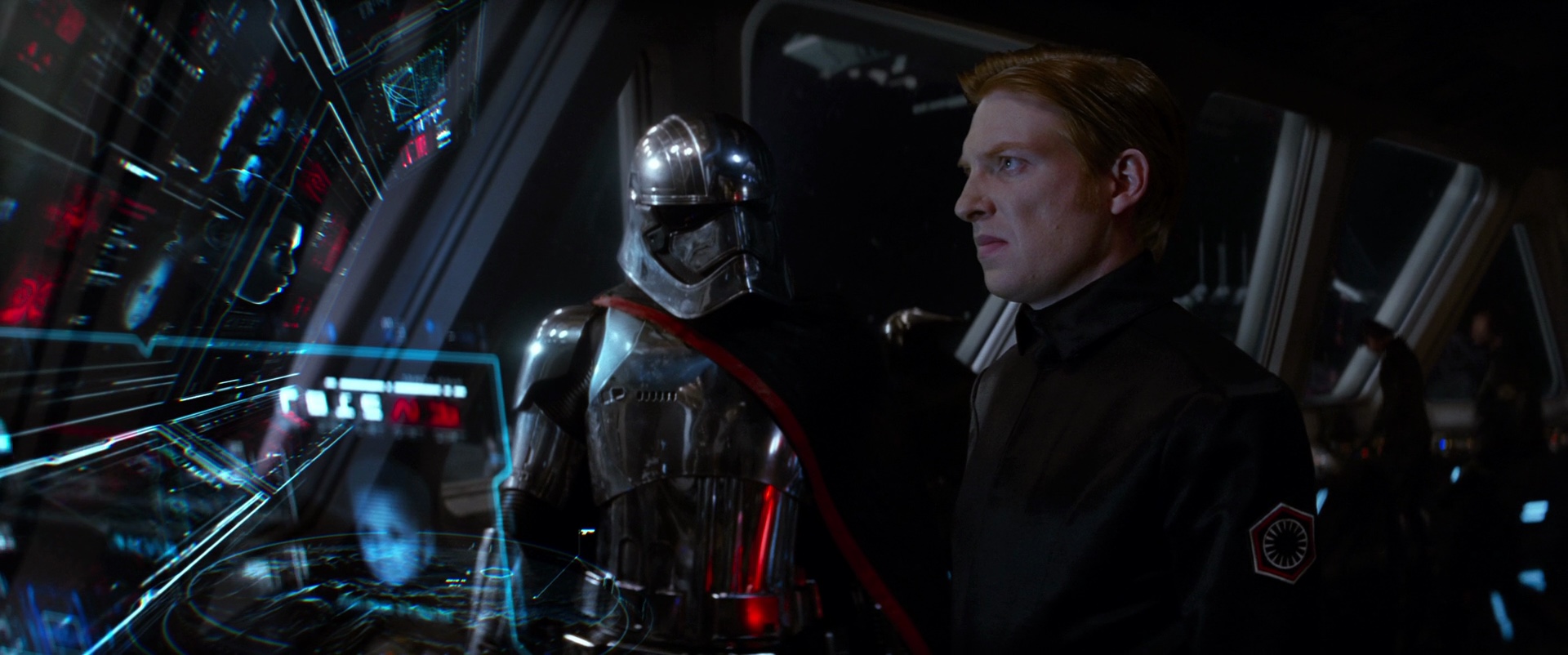
The First Order's strong idealogical beliefs alienated the Guild.
By the time of the Resistance, the Bounty Hunters' Guild had reformed into an organization Resistance Vice Admiral Amilyn Holdo saw as a potential partner against the First Order, an Imperial remnant with strong idealogical beliefs that the fellow Resistance member, Caluan Ematt, speculated to be the reason behind the Order's reluctance to do business with the guild. With reservations, Ematt agreed with Holdo's comment in The Rebel Files that the Resistance could form a successful partnership with the guild.
Decades prior, with the Empire's defeat in the Battle of Endor, the Guild hunter Seleno Chandro eventually left the organization as he gained a reputation for capturing Imperial fugitives. This reputation had left the former Guild hunter paranoid of First Order reprisals, although Chandro heeded the Resistance's call for assistance over Exegol and aided in the destruction of the Sith Order.
The Bounty Hunters' Guild was first mentioned in the 2014 canon junior novel Ezra's Gamble, written by Ryder Windham. It first appeared in Chapter 1 of Jon Favreau's 2019 television show The Mandalorian, directed by Dave Filoni, which aired on November 12, 2019. The Guild originated in the 1998 Star Wars Legends novel The Mandalorian Armor, written by K. W. Jeter.